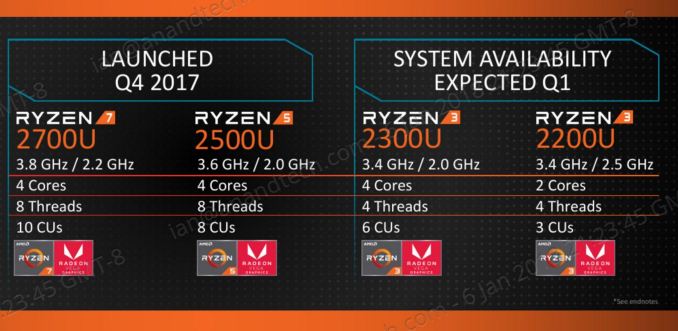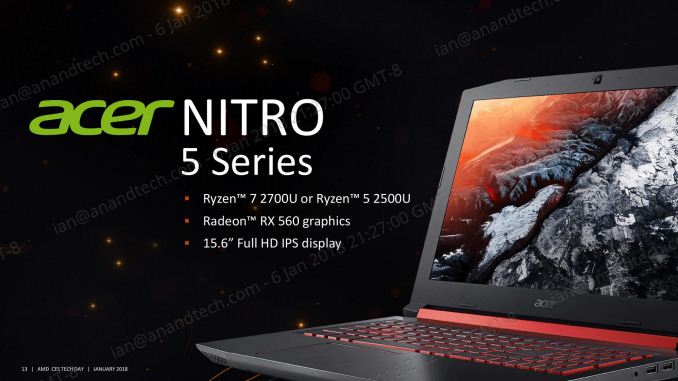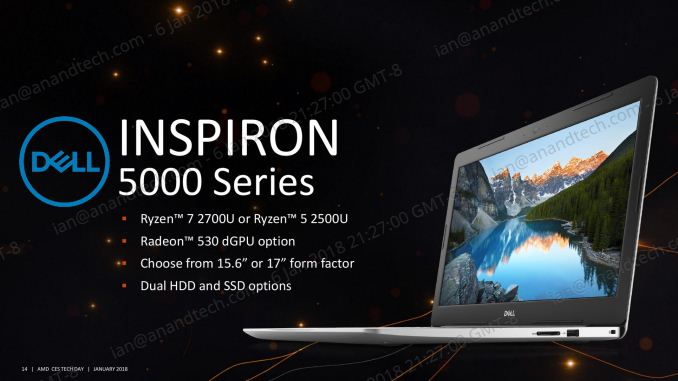AMD Tech Day at CES: 2018 Roadmap Revealed, with Ryzen APUs, Zen+ on 12nm, Vega on 7nm
by Ian Cutress on February 1, 2018 8:45 AM ESTZen Cores and Vega
Ryzen 3 Mobile, Plus More Ryzen Mobile Laptops
The most immediate announcement from AMD is two Ryzen 3 Mobile processors designed to fill out the Mobile stack, and the introduction of Ryzen-based APUs for desktop machines.
At the heart of both of these designs is the combination of AMD’s first-generation Zen cores, specifically four cores in a ‘core complex’, connected to Vega-based graphics integrated into the silicon. The two units are connected via AMD’s Infinity Fabric, designed for high-bandwidth and scale, and a feature that permeates through AMD’s recent product portfolio.
Ryzen Mobile
To date, AMD has already announced two products using this configuration. Both of them are for Ryzen Mobile, specifically the Ryzen 7 2700U and Ryzen 5 2500U, which have already been pre-announced in devices such as the HP Envy x2, the Lenovo Ideapad 720S, and the Acer Swift 3. Only the HP Envy x2 has been launched into the market so far (with mixed reviews due to the OEM design, which draws similar criticisms when equipped with Intel CPUs), with the others to see light in Q1 as well as other OEMs like Dell.
The first announcement is regarding adding more Ryzen Mobile processors to the family to cater for a wider audience. To pair with the Ryzen 7 Mobile and Ryzen 5 Mobile, AMD has two Ryzen 3 Mobile parts which will formally be available on January 9th with expected system availability within Q1.
| AMD Ryzen Mobile APUs | |||||
| Ryzen 7 2700U with Vega 10 |
Ryzen 5 2500U with Vega 8 |
Ryzen 3 2300U with Vega 6 |
Ryzen 3 2200U with Vega 3 |
FX-9800P (2015) |
|
| CPU | 4C / 8T 2.2 GHz Base 3.8 GHz Turbo Zen 14nm |
4C / 8T 2.0 GHz Base 3.8 GHz Turbo Zen 14nm |
4C / 4T 2.0 GHz Base 3.4 GHz Turbo Zen 14nm |
2C / 4T 2.5 GHz Base 3.4 GHz Turbo Zen 14nm |
Dual Module 2.7 GHz Base 3.6 GHz Turbo Excavator 28nm |
| GPU | Vega 10 10 CUs 640 SPs < 1300 MHz |
Vega 8 8 CUs 512 SPs < 1100 MHz |
Vega 6 6 CUs 384 SPs |
Vega 3 3 CUs 192 SPs |
GCN 1.2 8 CUs 512 SPs > 758 MHz |
| TDP | 15W | 15W | 15 W | 15 W | 15W |
| DRAM | Up to DDR4-2400 | DDR4-1866 | |||
| L2 Cache | 512 KB/core | 1 MB/module | |||
| L3 Cache | 1 MB/core | 4 MB/core | - | ||
| PCIe Lanes | ? | ? | ? | ? | 8 x PCIe 3.0 |
| Die Size | 209.78 mm2 | 250.4 mm2 | |||
| Transistors | 4.95 billion | 3.1 billion | |||
| Launch | October 2017 | January 2018 | May 2016 | ||
The Ryzen 3 2300U is a quad-core processor without simultaneous multithreading, which separates it from the other components. The base frequency of 2.0 GHz, a top turbo of 3.4 GHz, and a total of six compute units in the Vega graphics (this equates to 384 streaming processors). The Ryzen 3 2300U shares the same TDP as the other parts, coming in at 15W, and AMD wants to position this as a high-performance part for eSports capable notebooks, handily beating anything from Intel’s 7th Generation family.
The Ryzen 3 2200U is the only dual core component in AMD’s entire Ryzen product line, although it does have simultaneous multithreading to give it four threads in total. Having two fewer cores to fire up does give it a boost on the base frequency, coming in at 2.5 GHz, but the turbo frequency matches the other Ryzen 3 at 3.4 GHz. The 2200U is certainly the processor bringing up the rear, with only three compute units (192 streaming processors) in total, and helping AMD shift some of the processors that are not binned as aggressively as the higher-performance units.
AMD is promoting these two processors as capable elements of an entry level 15W notebook that can process DirectX 12, offer advanced video features, and be used in aesthetically pleasing designs with a long battery life, including 2-in-1s, ultrathin notebooks, and gaming laptops.
New Devices
Not to be content with just announcing a couple of new Ryzen Mobile processors, AMD was eager to promote new mobile devices that will be using Ryzen Mobile. To accompany the HP Envy x360, the Lenovo Ideapad 720S, and the Acer Swift 3, Q1 will see the launch of a new HP (under embargo until later this week), the Acer Nitro 5 series, and the Dell Inspiron 5000 series.
Acer’s Nitro line of laptops is typically aimed at the gaming crowd. The Nitro 5 dictates a 15.6-inch display, which in this case is a 1920x1080 IPS panel. Acer will use the pre-announced higher-end APUs, the Ryzen 7 2700U and Ryzen 5 2500U, but will also be pairing this with a Radeon RX 560 graphics chip. We were told by AMD that the integrated graphics and discrete graphics will be used in a switching context: for video playback, the lower power integrated graphics is used and the discrete is disabled, however the discrete graphics is fired up for gaming work. For compute, or for games that support multi-adaptor DirectX 12 technologies, both the integrated graphics and the discrete graphics should be available, however this is up to the game/software to implement.
The Dell Inspiron lines are more home/small-medium business-oriented devices, and here Dell is also using the Ryzen 7 2700U and Ryzen 5 2500U processors to offer peak Mobile APU performance. Designed more as a workhorse than for aesthetics, the Inspiron 5000 will offer AMD parts with 15.6-inch and 17-inch displays in a chassis that can support dual HDD/SSD options. The unit also comes with an optional Radeon 530 discrete GPU, which has 384 compute units based on AMD’s older GCN 1.0 architecture. This comes across as very odd, given that even the Ryzen 5 has 512 compute units of the newer Vega architecture. I can only assume that this provides extra displays for very specific customers, though for most it would seem an overly pointless addition.














131 Comments
View All Comments
haukionkannel - Monday, January 8, 2018 - link
Vega 7nm is for mobile first, so that is the priority in gpu. Only the desktop version in 2019.jjj - Monday, January 8, 2018 - link
Nor quite. Vega on 7nm is a SKU aimed at machine learning that samples in late 2018. That means volume in 2019 and other SKUs later , if there are other SKUs- I am unclear if AMD stated that there are other SKUs or that's an AT assumption.There is a possibility that Navi hits high end in 2019 and Vega lives bellow but that's kinda silly as AMD needs to be in a huge rush to replace Vega with something that is more competitive.
haukionkannel - Monday, January 8, 2018 - link
True. The machine learning chips Are the top priority I was just quessing that mobile part would Also get upgrade. My bad...So next Vega goes against machine learning Volta. Maybe Nvidia neither will release normal Volta, only those calculate monsters to AI projects. That would be interesting.
jjj - Wednesday, January 10, 2018 - link
Vega 7nm is 2019 for volumes it seem, Volta V100 will be replaced by something new likely this year and again in 2019- at the very least there will be one update.What Nvidia will do in consumer is unclear as there is no pressure on them to spend on releasing new things. The Intel+AMD part is problematic in laptop so likely they'll address that segment soon with something new.
Pinn - Monday, January 8, 2018 - link
Lisa is my waifu. I'm fine with my wife and daughter reading this.StevoLincolnite - Monday, January 8, 2018 - link
Ugh. No Navi until 2019. So AMD's graphics are guaranteed to be terrible for another year.Pinn - Monday, January 8, 2018 - link
and nvidia is guaranteed not to release volta for consumers.. fun.Xajel - Monday, January 8, 2018 - link
I was really hoping for a low power 8C/16T Ryzen CPU's, these can be used in SFF & laptops with dGPU already... these will be for those who want more CPU performance than GPU, or they need both CPU & GPU power.A5 - Monday, January 8, 2018 - link
You'll probably have to wait for 7nm for that. Current thermal budgets in laptop designs just aren't going to get you usable 16T performance from 35-45W.neblogai - Monday, January 8, 2018 - link
Table of Ryzen Mobile CPUs has all Raven Ridge APUs with '1MB per core'. But this is not true for R3 2200U, which still has the same 4MB of L3: http://www.amd.com/en-us/press-releases/Pages/ces-...Also- I still hope that is a Banded Kestrel die. On that topic, Joe Macri, when asked about RR use for fanless designs back in October, said it would not work too well, and would have to be clocked real low; when asked if they are building a different chip for that fanless market- answered only broadly- 'we love PCs,.. we want you to find AMD everywhere where PC is'. So I'm not sure- does that still mean only Stoney Ridge (if it qualifies for fanless), or a new die. Just looking at the AMD's below average power efficiency in RR laptops at browsing and playing video- maybe AMD knew they are simply not ready for fanless, and need to put in more work. But I still wish they released Zen 2C/4T 3CU - if not low power- then at least for even cheaper normal laptops. After all- Raven Ridge is not very small die at 210mm2, and a very cheap ~110mm2 die with 2c/4t Zen could also be successful.